The significance of Borobudur and Prambanan temples extends far beyond their architectural splendor; they’re pivotal in understanding Indonesia’s cultural landscape. Borobudur, with its intricate carvings and towering stupa, invites contemplation of spiritual enlightenment, while Prambanan’s soaring spires reflect the grandeur of Hindu mythology. Alongside other local temples, these sites not only draw travelers but also play essential roles in community identity and tradition preservation. As one explores these sacred spaces, the connections between history, culture, and spirituality become increasingly apparent, prompting questions about how these narratives continue to evolve today.
Good To Know
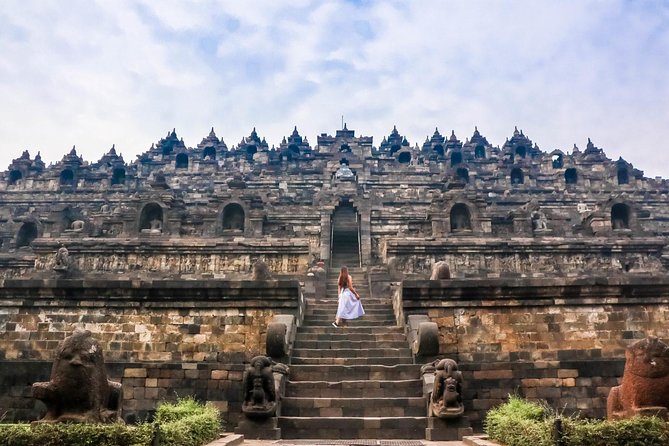
- Borobudur and Prambanan are UNESCO World Heritage sites showcasing intricate architecture and rich cultural significance.
- Borobudur features relief panels depicting Buddha’s life, while Prambanan is known for its stunning Hindu temples dedicated to deities.
- Both temples offer breathtaking views and are ideal for sunrise visits, enhancing the exploration experience.
- Local guides provide insights into the history and spirituality of these temples, enriching visitors’ understanding.
- Additional nearby temples can be explored, highlighting the region’s diverse religious and historical landscape.
Highlights of Borobudur Temple

Borobudur Temple, a stunning masterpiece of ancient architecture, stands as a testament to Indonesia’s rich cultural heritage.
This UNESCO World Heritage site, built in the 9th century, features intricate relief panels that narrate the life of Buddha and the path to enlightenment.
Visitors are captivated by its grand stupa at the summit, surrounded by 72 smaller stupas, each housing a Buddha statue.
The temple’s design embodies a mandala, symbolizing the universe and guiding pilgrims through its spiritual journey.
The breathtaking sunrise views from Borobudur create a magical atmosphere, enhancing its allure.
With expert English-speaking guides available, travelers gain deeper insights into Borobudur’s religious significance, making their visit not just memorable but also profoundly enriching.
You can also read our reviews of more tours and experiences in Yogyakarta.
Exploring Prambanan Temple
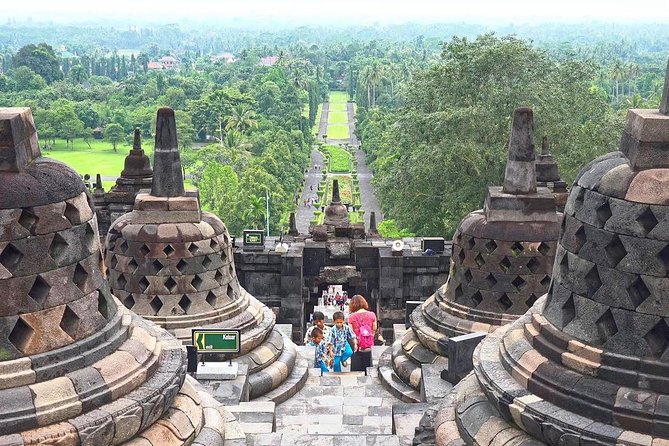
After experiencing the awe-inspiring Borobudur Temple, visitors can continue their journey to the remarkable Prambanan Temple, another UNESCO World Heritage site.
Known for its stunning Hindu architecture, Prambanan features towering spires that reach toward the sky, symbolizing the sacred Mount Meru. The temple complex, built in the 9th century, consists of three main temples dedicated to the gods Shiva, Vishnu, and Brahma.
As visitors explore, they’ll encounter intricate bas-reliefs depicting ancient tales and mythologies. Guided tours provide insights into the temple’s rich history and cultural significance.
With an air-conditioned vehicle and included entrance fees, the trip ensures a comfortable and informative experience, allowing travelers to fully appreciate the beauty and heritage of this iconic site.
Significance of Local Temples
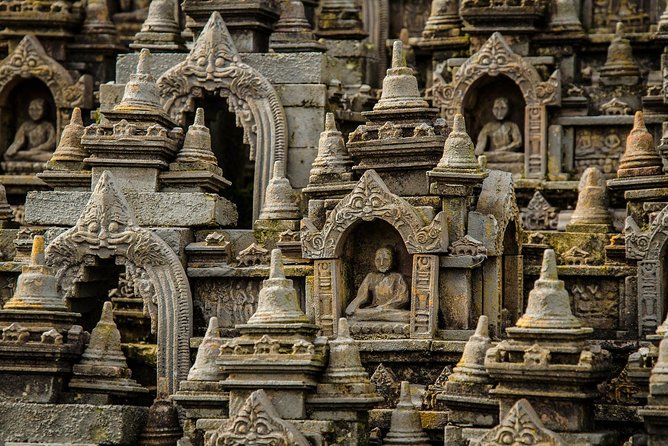
Local temples in Java hold immense significance, serving not only as places of worship but also as cultural landmarks that embody the rich history and spirituality of the region.
These sacred sites attract visitors for their architectural beauty, intricate carvings, and deep-rooted traditions.
-
They foster community bonds through shared rituals and festivals.
-
Temples serve as educational resources, offering insights into ancient beliefs and practices.
-
They contribute to local economies by attracting travelers and promoting cultural heritage.
Tour Itinerary Overview
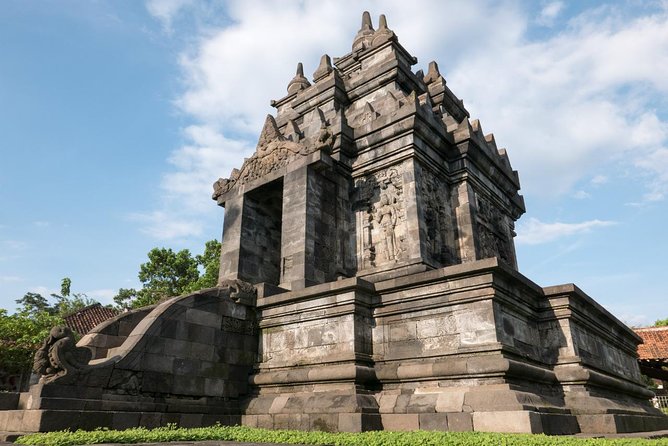
Embarking on this captivating day trip from Yogyakarta, travelers can expect an enriching itinerary that highlights the awe-inspiring Borobudur and Prambanan temples.
The journey commences at 08:00 am, allowing plenty of time to explore these UNESCO World Heritage Sites. First, visitors explore the majestic Borobudur, where they’ll marvel at its intricate carvings and stunning views.
Afterward, the tour continues to Prambanan, where the impressive Hindu temples showcase breathtaking architecture and rich history.
Throughout the day, knowledgeable English-speaking guides provide insights into the cultural and religious significance of each site.
The efficient organization of the tour ensures that participants experience the best of both temples, making it a memorable adventure in Java’s historical landscape.
Amenities Included in Tour
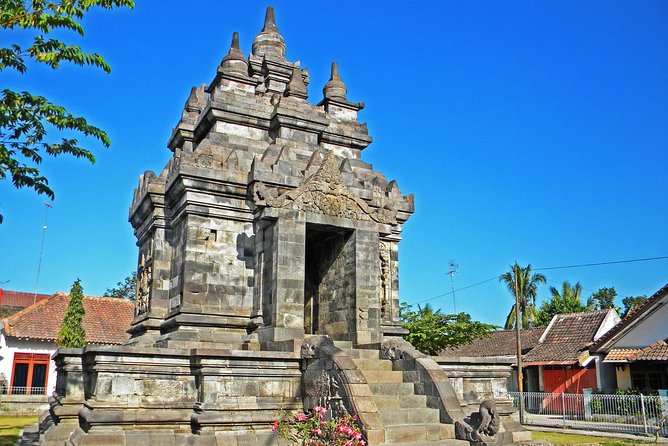
Travelers can expect a range of included amenities that enhance their experience during the Borobudur and Prambanan tour.
The thoughtful arrangements ensure a comfortable and enjoyable visit to these iconic sites.
- An air-conditioned vehicle provides comfort throughout the journey.
- Mineral water is provided to keep travelers hydrated.
- All entrance fees and taxes are covered, granting access to the temple courtyards.
With these amenities, participants can focus on soaking in the breathtaking architecture and rich history without worrying about logistics.
The combination of comfort, convenience, and access makes this tour an inviting choice for those eager to explore Java’s remarkable cultural heritage.
Optional Experiences Available
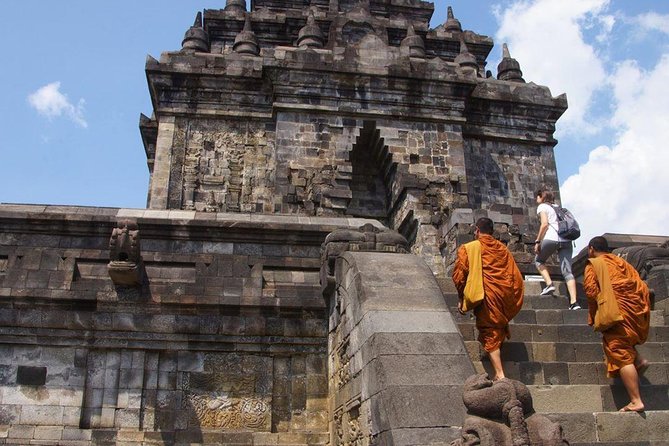
Enhancing the tour experience, optional add-ons provide travelers with the chance to delve deeper into the rich history of Borobudur and Prambanan.
Visitors can opt for a local English-speaking guide at each temple, gaining insights into the architectural marvels and their cultural significance.
For those looking to capture the moment, photography sessions are available, allowing travelers to take home stunning images of the majestic structures.
Plus, themed workshops on traditional crafts or culinary experiences can enrich the journey, providing a hands-on understanding of the local culture.
While personal expenses, food, and beverages aren’t included, these optional experiences add unique layers to the exploration, making the adventure all the more memorable.
Pickup Locations and Charges
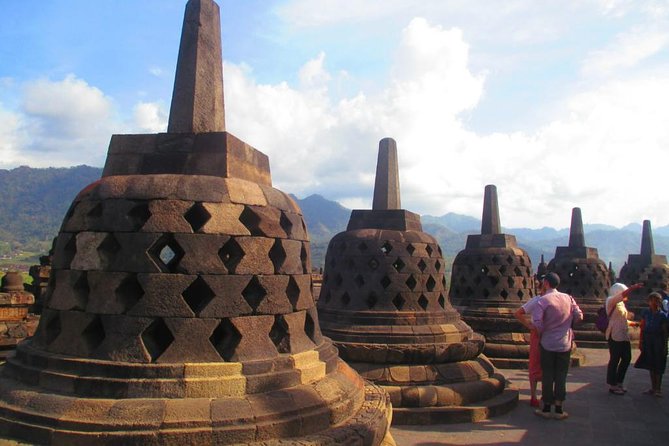
For a seamless experience, convenient pickup options are available for those joining the Borobudur and Prambanan tour.
Travelers staying in the Yogyakarta city area enjoy free hotel pickups, ensuring a hassle-free start to their adventure.
For those outside the city, additional charges apply based on their location:
- IDR 150,000: Wonosari, Klaten, Parangtritis, Kulonprogo, Magelang, Borobudur
- IDR 300,000: Solo, Losari, Purworejo, Bandungan
- IDR 400,000: Semarang, Kutoarjo, Wonosobo, Temanggung
These options make it easy for everyone to join the tour while accommodating various locations.
Accessibility and Participation Details
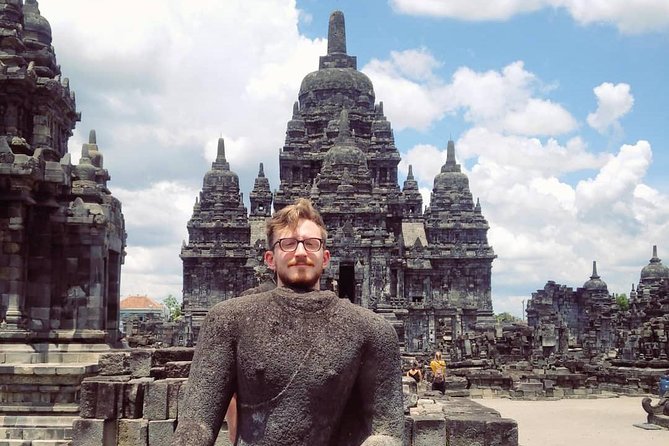
Most participants can easily join the Borobudur and Prambanan tour, as the itinerary is designed to accommodate a wide range of visitors.
The tour kicks off at 08:00 am, providing ample time to explore these magnificent UNESCO sites. While the tour isn’t wheelchair accessible, it welcomes most travelers, ensuring a memorable experience.
Infants must sit on laps, and a private tour option guarantees a more personalized experience. Booking confirmation is received promptly, and current COVID-19 guidelines allow limited access only to temple courtyards.
For those needing additional assistance, local guides are available at the temples for a deeper understanding of the sites. The tour offers a practical and engaging way to explore Java’s rich cultural heritage.
Frequently Asked Questions
What Is the Best Time to Visit Borobudur and Prambanan Temples?
The best time to visit is early morning or late afternoon. During these hours, visitors enjoy cooler temperatures and stunning views while avoiding crowds, enhancing their experience at these iconic historical sites.
Are There Any Dress Code Requirements for Visiting the Temples?
Visitors should wear modest clothing when visiting the temples. Shoulders and knees need to be covered, and loose-fitting attire is recommended. This respectful dress code enhances the spiritual experience and aligns with local cultural norms.
Can I Take Photos Inside the Temple Premises?
Visitors can take photos inside the temple premises, but they should respect the sacredness of the location. It’s important to observe any specific guidelines provided by the site to ensure a respectful experience.
Is There a Guidebook Available for Self-Exploration?
He’s found that many popular tourist attractions offer guidebooks for self-exploration. These guidebooks often provide valuable insights, helping visitors appreciate the historical significance and details of each site while enhancing their overall experience.
Are There Souvenir Shops at the Temples?
Visitors often find souvenir shops at various temple sites, offering unique local crafts and mementos. These shops provide an opportunity to take home a piece of the cultural experience, enhancing their journey and memories.
The Sum Up
In summary, Borobudur and Prambanan temples stand as pillars of Indonesia’s cultural heritage, drawing visitors with their breathtaking architecture and rich history. Together with other local temples, they offer a deeper understanding of the region’s spiritual traditions and community connections. Whether exploring the intricate reliefs of Borobudur or the grandeur of Prambanan, travelers will find an unforgettable experience that highlights Indonesia’s past and present. Don’t miss the chance to learn about this captivating cultural journey.
More Tour Reviews in Yogyakarta
- Yogyakarta: Borobudur and Prambanan Temples Guided Tour
- YOGYAKARTA ; MERAPI VULCANO JEEP TOUR AND PRAMBANAN TEMPEL
- Kembang Soka Waterfall: A Refreshing Nature Escape
- Yogayakarta : Jomblang Cave and Pindul Cave Tour
- Yogyakarta: Jomblang Cave, Pindul Cave and Oyo River Tubing
- Yogyakarta: Borobudur Climb and VW Safari Tour
Not for you? Here's more nearby things to do in Yogyakarta we have reviewed
- Yogyakarta: Borobudur and Prambanan Temples Guided Tour
- YOGYAKARTA ; MERAPI VULCANO JEEP TOUR AND PRAMBANAN TEMPEL
- Kembang Soka Waterfall: A Refreshing Nature Escape
- Yogayakarta : Jomblang Cave and Pindul Cave Tour
- Yogyakarta: Jomblang Cave, Pindul Cave and Oyo River Tubing
- Yogyakarta: Borobudur Climb and VW Safari Tour
- Yogyakarta: Sunset at Prambanan Temple & Ramayana Ballet
- Yogyakarta: JOMBLANG CAVE Adventure with LIVE DRONE Shoot
- Yogyakarta : merapi sunrise, jomblang and pindul caves trip
- YOGYAKARTA CITY TOUR,SULTAN PALACE,WATER CASTLE AND CRAFTS.
- UNESCO Tour: Borobudur Top Access (Ticket Help) & Prambanan
- Yogyakarta: Mount Bromo and Ijen Volcano Tour to Bali
